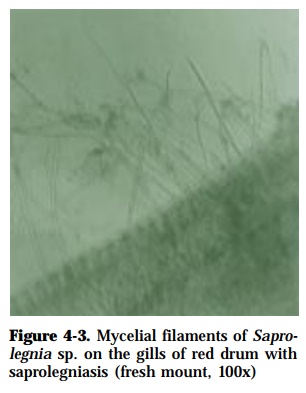Chapter: Health Management in Aquaculture: Fungal diseases
Saprolegniosis (Saprolegniasis) - Fungal Diseases of Fish
Saprolegniosis (Saprolegniasis)
CAUSATIVE AGENTS:
Saprolegnia spp., Achlya spp., and Aphanomyces spp.
SPECIES AFFECTED:
Many freshwater fish (e.g. carps, goldfish)
GROSS SIGNS:
Formations of white cottony growth on fish eggs and on affected tissues of fish. Virtually, any area on the surface of a fish may become infected but it is usually the integuments that are involved. Gills, eyes and olfactory pits may also be-come infected (Fig. 4-3). The color of the mycelium may also vary from white to brownish, depending on the color of the particles, which get trapped on the mycelium.

EFFECTS ON HOSTS:
Once infection is initiated, it is generally progressive and terminal. Affected fish become increasingly lethargic, tires more easily and becomes less responsive to external stimuli. Loss of equilibrium often occurs shortly before death. Histo-pathologically, evidence of rapid destruction of epidermis (tissue necrosis) with slight inflammatory response can be observed.
DIAGNOSIS:
Microscopic examination of the cottony growth from the affected tissues will reveal the characteristic hyaline and coenocytic mycelia. Usually, numerous sporangia will be present. If sporangia are present, one can often make a tenta-tive generic identification. However, it must be remembered that other infec-tions (viral, bacterial, protozoan) that are less easy to diagnose might also be present, and that the occurrence of a saprolegnian infection can mask the char-acteristic signs of these diseases.
PREVENTION AND CONTROL:
Prevention and treatment of saprolegnian infections of fishes and fish eggs have attracted much attention for a long time now. A vast array of chemicals has been tested for effectiveness against these fungi in vitro. Common chemicals used as chemotherapeutants include bath treatments of either of the following:
• Zinc-free malachite green (0.1% on wound and rinse; 67 mg/L for 1 min; 0.2 mg/L for 1 h; 0.1 mg/L indefinite). Cautions: persistent tissue levels; mu-tagenic; teratogenic; treatment can result in gill damage; more toxic at warm temperatures. Malachite green is considered as the most popular antimy-cotic agent, being inexpensive and highly effective fungicide. This com-pound also allows a wide margin of error between therapeutic and toxic dosages.
• Sodium chloride (22 g/L for 30 min; 30 g/L for 10 min; 1-3 g/L indefinite). This compound is safe to use and inexpensive.
• Formalin (0.4-0.5 ml/L 30% formaldehyde for 1 h). Inexpensive and popular chemoprophylactic and chemotherapeutic agent.
Related Topics